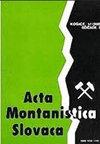The development of the blast furnace metallurgy of the iron in Slovakia
IF 1.4
4区 地球科学
Q2 GEOSCIENCES, MULTIDISCIPLINARY
引用次数: 0
Abstract
Easily available sources of iron ore, the abundance of hydropower, and wood for charcoal were the prerequisites for the development of iron metallurgy in Slovakia. Since the 16th century, the bloomery process used in iron metallurgy has been gradually replaced by the blast furnace process. This new process was more economical, but it required extremely high investments. The steam engine replaced the unreliable water power in the blowing process, and coke replaced charcoal. Especially due to economic problems, the first blast furnaces in Slovakia started to be built about two hundred years later than in Western Europe. Despite the promising start, the installation of steam engines was lagging. A major drawback was the lack of road and rail networks combined with the absence of local coking coal. The introductory part of the paper compares chronologically the individual stages of the development of blast furnace production in Slovakia and abroad. Next, the paper presents comprehensive results of the analysis of samples of the slag found at 59 sites of extinct ironworks with a blast furnace, localised until now. The samples were analysed by metallographic, chemical, spectral (secondary and trace elements), and X-ray methods. In the past, these data were published with territorial restrictions and mostly in a language other than Slovak. The contents of secondary and trace elements in slag from individual sites using cluster analysis and also metallic iron content in slags categorised according to owners of the blast furnaces and the slag basicity are compared.斯洛伐克高炉炼铁技术的发展
容易获得的铁矿石来源、丰富的水电和木炭用木材是斯洛伐克发展铁冶金的先决条件。自16世纪以来,用于铁冶金的冶炼工艺已逐渐被高炉工艺所取代。这种新工艺更经济,但需要极高的投资。蒸汽机取代了鼓风过程中不可靠的水力,焦炭取代了木炭。特别是由于经济问题,斯洛伐克的第一座高炉比西欧晚了大约200年才开始建造。尽管起步很有希望,但蒸汽机的安装却滞后了。一个主要的缺点是缺乏公路和铁路网络,再加上当地没有焦煤。论文的引言部分按时间顺序比较了斯洛伐克和国外高炉生产发展的各个阶段。接下来,本文介绍了迄今为止在59个带高炉的废弃钢铁厂遗址发现的炉渣样本的综合分析结果。通过金相、化学、光谱(二次元素和微量元素)和X射线方法对样品进行了分析。过去,这些数据是在有领土限制的情况下发布的,而且大多是用斯洛伐克语以外的语言发布的。采用聚类分析法对各个地点炉渣中的二次元素和微量元素含量以及根据高炉所有者分类的炉渣中的金属铁含量和炉渣碱度进行了比较。
本文章由计算机程序翻译,如有差异,请以英文原文为准。
求助全文
约1分钟内获得全文
求助全文
来源期刊

Acta Montanistica Slovaca
地学-地球科学综合
CiteScore
3.60
自引率
12.50%
发文量
60
审稿时长
30 weeks
期刊介绍:
Acta Montanistica Slovaca publishes high quality articles on basic and applied research in the following fields:
geology and geological survey;
mining;
Earth resources;
underground engineering and geotechnics;
mining mechanization, mining transport, deep hole drilling;
ecotechnology and mineralurgy;
process control, automation and applied informatics in raw materials extraction, utilization and processing;
other similar fields.
Acta Montanistica Slovaca is the only scientific journal of this kind in Central, Eastern and South Eastern Europe.
The submitted manuscripts should contribute significantly to the international literature, even if the focus can be regional. Manuscripts should cite the extant and relevant international literature, should clearly state what the wider contribution is (e.g. a novel discovery, application of a new technique or methodology, application of an existing methodology to a new problem), and should discuss the importance of the work in the international context.
 求助内容:
求助内容: 应助结果提醒方式:
应助结果提醒方式:


